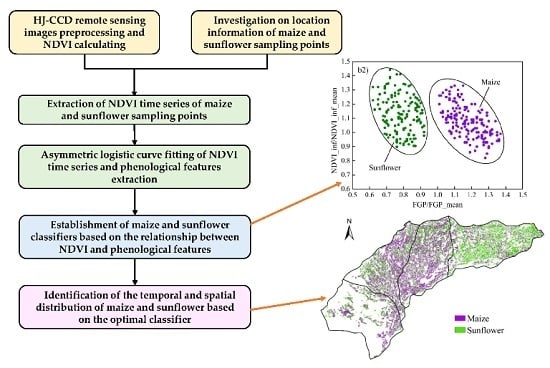Multi-Year Mapping of Maize and Sunflower in Hetao Irrigation District of China with High Spatial and Temporal Resolution Vegetation Index Series
Abstract
:1. Introduction
2. Study Region and Data Sources
2.1. Study Region
2.2. Sampling and Verification Data
2.3. Satellite Data and Preprocessing
2.4. Other Dataset
3. Phenology-Based Crop Identification
3.1. Derivation of Phenological Metrics
3.2. Crop Identification Model of Characteristic Ellipses
4. Results and Discussion
4.1. Comparison of Identification Results of Nine Classifiers
4.2. Crop Identification Results Based on Optimal Classifier
4.3. Spatial and Temporal Distribution of Maize and Sunflower
5. Conclusions
- The reconstructed NDVI time series based on HJ-1A/1BCCD images could represent the phenological characteristics of maize and sunflower in the study area, and the phenological characteristics of these two crops had significant differences in the NDVI increasing period. The crop identification ellipse normalized with mean grassland NDVI_inf as the NDVI characteristic and FGP as the phenological metric were proved to be the optimal identification ellipse. In future studies, other vegetation indexes can also be used as classification factors for comparative analysis.
- The multi-year spatial distribution of maize and sunflower in the study area could be effectively identified with the Kappa value of consistency test of 0.62. The sunflower classifier performed better than maize.
- The planting areas of maize and sunflower were increasing during the study years. Maize was mainly distributed in Hangjinhouqi and Linhe, while sunflower mainly in Wuyuan, and the planting sites of sunflower were gradually expanded from Wuyuan to the northern part of Hangjinhouqi and Linhe, and these results were in agreement with the local economic policy.
Acknowledgments
Author Contributions
Conflicts of Interest
References
- Johnson, D.M. An assessment of pre- and within-season remotely sensed variables for forecasting corn and soybean yields in the United States. Remote Sens. Environ. 2014, 141, 116–128. [Google Scholar] [CrossRef]
- Shao, Y.; Campbell, J.B.; Taff, G.N.; Zheng, B. An analysis of cropland mask choice and ancillary data for annual corn yield forecasting using MODIS data. Int. J. Appl. Earth Obs. Geoinf. 2015, 38, 78–87. [Google Scholar] [CrossRef]
- Jiang, Y.; Xu, X.; Huang, Q.; Huo, Z.; Huang, G. Assessment of irrigation performance and water productivity in irrigated areas of the middle Heihe River basin using a distributed agro-hydrological model. Agric. Water Manag. 2015, 147, 67–81. [Google Scholar] [CrossRef]
- Ren, D.; Xu, X.; Hao, Y.; Huang, G. Modeling and assessing field irrigation water use in a canal system of Hetao, upper Yellow River basin: Application to maize, sunflower and watermelon. J. Hydrol. 2016, 532, 122–139. [Google Scholar] [CrossRef]
- Thenkabail, P.S.; Biradar, C.M.; Noojipady, P.; Dheeravath, V.; Li, Y.; Velpuri, M.; Gumma, M.; Gangalakunta, O.R.P.; Turral, H.; et al. Global irrigated area map (GIAM), derived from remote sensing, for the end of the last millennium. Int. J. Remote Sens. 2009, 30, 3679–3733. [Google Scholar] [CrossRef]
- Li, X. Change of arable land area in China during the past 20 years and its policy implications. J. Nat. Resour. 1999, 4, 329–333, (In Chinese with English Abstract). [Google Scholar]
- Gómez, C.; White, J.C.; Wulder, M.A. Optical remotely sensed time series data for land cover classification: A review. ISPRS J. Photogramm. Remote Sens. 2016, 116, 55–72. [Google Scholar] [CrossRef]
- Liu, J.; Liu, M.; Tian, H.; Zhuang, D.; Zhang, Z.; Zhang, W.; Tang, X.; Deng, X. Spatial and temporal patterns of China’s cropland during 1990–2000: An analysis based on Landsat TM data. Remote Sens. Environ. 2005, 98, 442–456. [Google Scholar] [CrossRef]
- Wardlow, B.D.; Egbert, S.L. Large-area crop mapping using time-series MODIS 250 m NDVIdata: An assessment for the U.S. Central Great Plains. Remote Sens. Environ. 2008, 112, 1096–1116. [Google Scholar] [CrossRef]
- Xue, Z.; Du, P.; Li, J.; Su, H. Sparse graph regularization for robust crop mapping using hyperspectral remotely sensed imagery with very few in situ data. ISPRS J. Photogramm. Remote Sens. 2017, 124, 1–15. [Google Scholar] [CrossRef]
- Jiang, L.; Shang, S.; Yang, Y.; Guan, H. Mapping interannual variability of maize cover in a large irrigation district using a vegetation index-phenological index classifier. Comput. Electron. Agric. 2016, 123, 351–361. [Google Scholar] [CrossRef]
- Zhong, L.; Hu, L.; Yu, L.; Gong, P.; Biging, G.S. Automated mapping of soybean and corn using phenology. ISPRS J. Photogramm. Remote Sens. 2016, 119, 151–164. [Google Scholar] [CrossRef]
- Löw, F.; Conrad, C.; Michel, U. Decision fusion and non-parametric classifiers for land use mapping using multi-temporal RapidEye data. ISPRS J. Photogramm. Remote Sens. 2015, 108, 191–204. [Google Scholar] [CrossRef]
- Chen, Y.; Song, X.; Wang, S.; Huang, J.; Mansaray, L.R. Impacts of spatial heterogeneity on crop area mapping in Canada using MODIS data. ISPRS J. Photogramm. Remote Sens. 2016, 119, 451–461. [Google Scholar] [CrossRef]
- Shao, Y.; Taff, G.N.; Ren, J.; Campbell, J.B. Characterizing major agricultural land change trends in the Western Corn Belt. ISPRS J. Photogramm. Remote Sens. 2016, 122, 116–125. [Google Scholar] [CrossRef]
- Lunetta, R.S.; Shao, Y.; Ediriwickrema, J.; Lyon, J.G. Monitoring agricultural cropping patterns across the Laurentian Great Lakes Basin using MODIS-NDVI data. Int. J. Appl. Earth Obs. Geoinf. 2010, 12, 81–88. [Google Scholar] [CrossRef]
- Shao, Y.; Lunetta, R.S. Comparison of support vector machine, neural network, and CART algorithms for the land-cover classification using limited training data points. ISPRS J. Photogramm. Remote Sens. 2012, 70, 78–87. [Google Scholar] [CrossRef]
- Barrett, B.; Nitze, I.; Green, S.; Cawkwell, F. Assessment of multi-temporal, multi-sensor radar and ancillary spatial data for grasslands monitoring in Ireland using machine learning approaches. Remote Sens. Environ. 2014, 152, 109–124. [Google Scholar] [CrossRef]
- Zhu, W.; Pan, Y.; He, H.; Wang, L.; Mou, M.; Liu, J. A Changing-Weight Filter Method for Reconstructing a High-Quality NDVI Time Series to Preserve the Integrity of Vegetation Phenology. IEEE Trans. Geosci. Remote Sens. 2012, 50, 1085–1094. [Google Scholar] [CrossRef]
- Zhong, L.; Gong, P.; Biging, G.S. Efficient corn and soybean mapping with temporal extendability: A multi-year experiment using Landsat imagery. Remote Sens. Environ. 2014, 140, 1–13. [Google Scholar] [CrossRef]
- Ghosh, A.; Joshi, P.K. A comparison of selected classification algorithms for mapping bamboo patches in lower Gangetic plains using very high resolution WorldView 2 imagery. Int. J. Appl. Earth Obs. Geoinf. 2014, 26, 298–311. [Google Scholar] [CrossRef]
- Belgiu, M.; Drăguţ, L. Random forest in remote sensing: A review of applications and future directions. ISPRS J. Photogramm. Remote Sens. 2016, 114, 24–31. [Google Scholar] [CrossRef]
- Gislason, P.O.; Benediktsson, J.A.; Sveinsson, J.R. Random Forests for land cover classification. Pattern Recogn. Lett. 2006, 27, 294–300. [Google Scholar] [CrossRef]
- Zhong, L.; Hawkins, T.; Biging, G.; Gong, P. A phenology-based approach to map crop types in the San Joaquin Valley, California. Int. J. Remote Sens. 2011, 32, 7777–7804. [Google Scholar] [CrossRef]
- Hmimina, G.; Dufrêne, E.; Pontailler, J.Y.; Delpierre, N.; Aubinet, M.; Caquet, B.; De Grandcourt, A.; Burban, B.; Flechard, C.; Granier, A.; et al. Evaluation of the potential of MODIS satellite data to predict vegetation phenology in different biomes: An investigation using ground-based NDVI measurements. Remote Sens. Environ. 2013, 132, 145–158. [Google Scholar] [CrossRef]
- Parplies, A.; Dubovyk, O.; Tewes, A.; Mund, J.; Schellberg, J. Phenomapping of rangelands in South Africa using time series of RapidEye data. Int. J. Appl. Earth Obs. Geoinf. 2016, 53, 90–102. [Google Scholar] [CrossRef]
- Walker, J.J.; de Beurs, K.M.; Wynne, R.H. Dryland vegetation phenology across an elevation gradient in Arizona, USA, investigated with fused MODIS and Landsat data. Remote Sens. Environ. 2014, 144, 85–97. [Google Scholar] [CrossRef]
- Li, L.; Friedl, M.; Xin, Q.; Gray, J.; Pan, Y.; Frolking, S. Mapping Crop Cycles in China Using MODIS-EVI Time Series. Remote Sens. 2014, 6, 2473–2493. [Google Scholar] [CrossRef]
- Pan, Z.; Huang, J.; Zhou, Q.; Wang, L.; Cheng, Y.; Zhang, H.; Blackburn, G.A.; Yan, J.; Liu, J. Mapping crop phenology using NDVI time-series derived from HJ-1A/B data. Int. J. Appl. Earth Obs. Geoinf. 2015, 34, 188–197. [Google Scholar] [CrossRef]
- Huete, A.; Didan, K.; Miura, T.; Rodriguez, E.P.; Gao, X. Overview of the radiometric and biophysical performance of the MODIS vegetation indices. Remote Sens. Environ. 2002, 83, 195–213. [Google Scholar] [CrossRef]
- Sehgal, V.K.; Jain, S.; Aggarwal, P.K.; Jha, S. Deriving Crop Phenology Metrics and Their Trends Using Times Series NOAA-AVHRR NDVI Data. J. Indian Soc. Remote Sens. 2011, 39, 373–381. [Google Scholar] [CrossRef]
- Lu, L.; Kuenzer, C.; Wang, C.; Guo, H.; Li, Q. Evaluation of Three MODIS-Derived Vegetation Index Time Series for Dryland Vegetation Dynamics Monitoring. Remote Sens. 2015, 7, 7597–7614. [Google Scholar] [CrossRef] [Green Version]
- Johnson, M.D.; Hsieh, W.W.; Cannon, A.J.; Davidson, A.; Bédard, F. Crop yield forecasting on the Canadian Prairies by remotely sensed vegetation indices and machine learning methods. Agric. For. Meteorol. 2016, 218–219, 74–84. [Google Scholar] [CrossRef]
- Martínez, B.; Gilabert, M.A. Vegetation dynamics from NDVI time series analysis using the wavelet transform. Remote Sens. Environ. 2009, 113, 1823–1842. [Google Scholar] [CrossRef]
- Yang, C.; Everitt, J.H.; Murden, D. Evaluating high resolution SPOT 5 satellite imagery for crop identification. Comput. Electron. Agric. 2011, 75, 347–354. [Google Scholar] [CrossRef]
- Wardlow, B.; Egbert, S.; Kastens, J. Analysis of time-series MODIS 250 m vegetation index data for crop classification in the U.S. Central Great Plains. Remote Sens. Environ. 2007, 108, 290–310. [Google Scholar] [CrossRef]
- Fritz, S.; Massart, M.; Savin, I.; Gallego, J.; Rembold, F. The use of MODIS data to derive acreage estimations for larger fields: A case study in the south-western Rostov region of Russia. Int. J. Appl. Earth Obs. Geoinf. 2008, 10, 453–466. [Google Scholar] [CrossRef]
- Otukei, J.R.; Blaschke, T. Land cover change assessment using decision trees, support vector machines and maximum likelihood classification algorithms. Int. J. Appl. Earth Obs. Geoinf. 2010, 12, S27–S31. [Google Scholar] [CrossRef]
- Hansen, M.C.; Loveland, T.R. A review of large area monitoring of land cover change using Landsat data. Remote Sens. Environ. 2012, 122, 66–74. [Google Scholar] [CrossRef]
- Ke, Y.; Im, J.; Park, S.; Gong, H. Downscaling of MODIS One Kilometer Evapotranspiration Using Landsat-8 Data and Machine Learning Approaches. Remote Sens. 2016, 8, 215–241. [Google Scholar] [CrossRef]
- Otukei, J.R.; Blaschke, T.; Collins, M. Fusion of TerraSAR-x and Landsat ETM+ data for protected area mapping in Uganda. Int. J. Appl. Earth Obs. Geoinf. 2015, 38, 99–104. [Google Scholar] [CrossRef]
- Wang, Q.; Tenhunen, J.; Dinh, N.Q.; Reichstein, M.; Vesala, T.; Keronen, P. Similarities in ground- and satellite-based NDVI time series and their relationship to physiological activity of a Scots pine forest in Finland. Remote Sens. Environ. 2004, 93, 225–237. [Google Scholar] [CrossRef]
- Wang, Q. Technical system design and construction of China’s HJ-1 satellites. Int. J. Digit. Earth 2012, 5, 202–216. [Google Scholar] [CrossRef]
- Sun, C.; Liu, Y.; Zhao, S.; Zhou, M.; Yang, Y.; Li, F. Classification mapping and species identification of salt marshes based on a short-time interval NDVI time-series from HJ-1 optical imagery. Int. J. Appl. Earth Obs. Geoinf. 2016, 45, 27–41. [Google Scholar] [CrossRef]
- Wang, Q.; Wu, C.; Li, Q.; Li, J. Chinese HJ-1A/B satellites and data characteristics. Sci. China Earth Sci. 2010, 53, 51–57. [Google Scholar] [CrossRef]
- Sobrino, J.A.; Jiménez-Muñoz, J.C.; Paolini, L. Land surface temperature retrieval from LANDSAT TM 5. Remote Sens. Environ. 2004, 90, 434–440. [Google Scholar] [CrossRef]
- Wang, Y.; Liu, Y.; Li, M.; Tan, L. The reconstruction of abnormal segments in HJ-1A/B NDVI time series using MODIS: A statistical method. Int. J. Remote Sens. 2014, 35, 7991–8007. [Google Scholar] [CrossRef]
- Allen, R.G.; Tasumi, M.; Trezza, R. Satellite-Based Energy Balance for Mapping Evapotranspiration with Internalized Calibration(METRIC)-Model. J. Irrig. Drain. Eng. 2007, 133, 380–394. [Google Scholar] [CrossRef]
- Brown, J.; Loveland, T.; Merchant, J.; Reed, B.; Ohlen, D. Using Multisource Data in Global Land Cover Characterization Concepts, Requirements and Methods. Photogramm. Eng. Remote Sens. 1993, 59, 977–987. [Google Scholar]
- Royo, C.; Aparicio, N.; Blanco, R.; Villegas, D. Leaf and green area development of durum wheat genotypes grown under Mediterranean conditions. Eur. J. Agron. 2004, 20, 419–430. [Google Scholar] [CrossRef]
- Sim, J.; Wright, C.C. The Kappa Statistic in Reliability Studies: Use, Interpretation, and Sample Size Requirements. Phys. Ther. 2005, 85, 257–268. [Google Scholar] [PubMed]


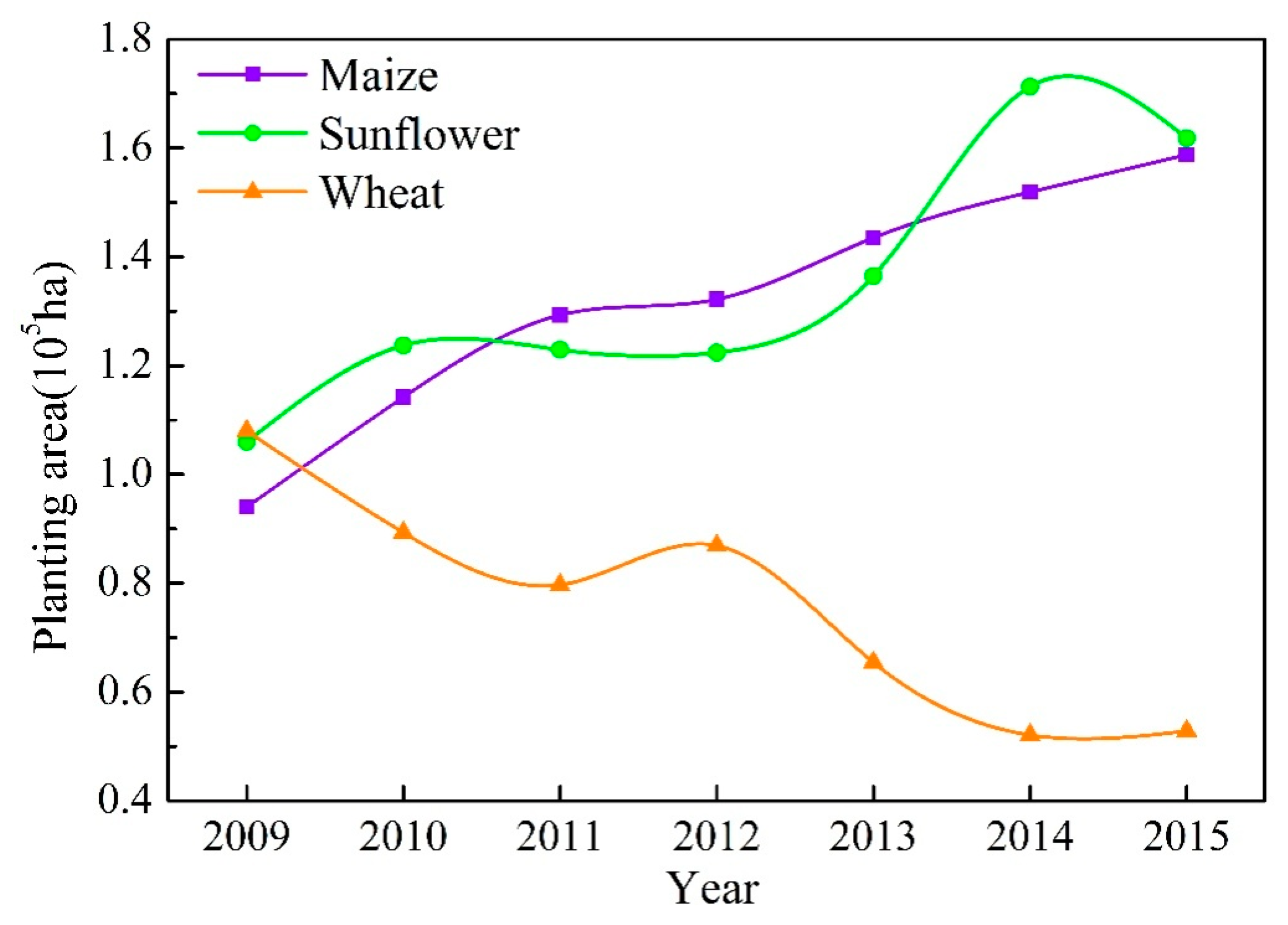
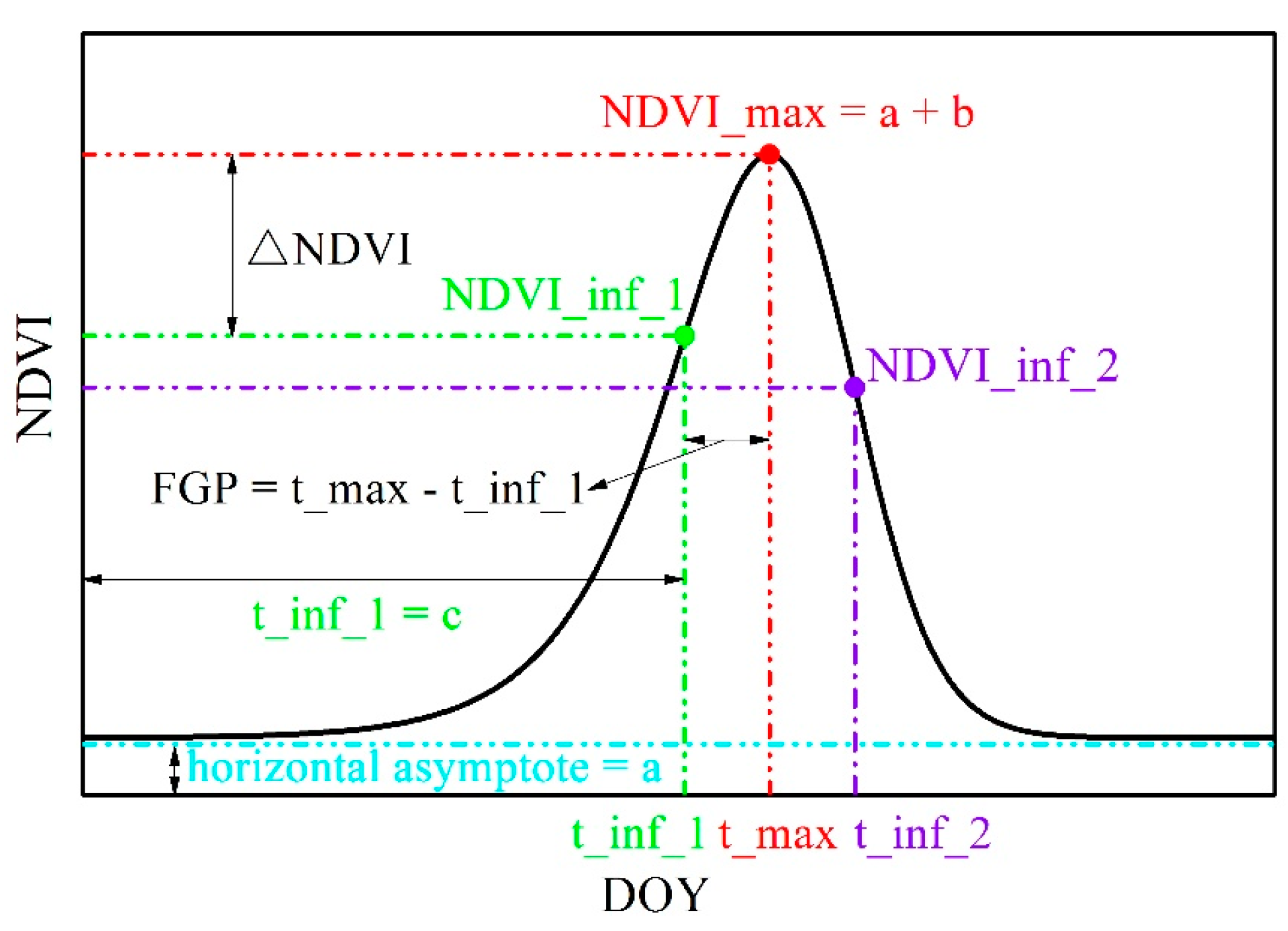


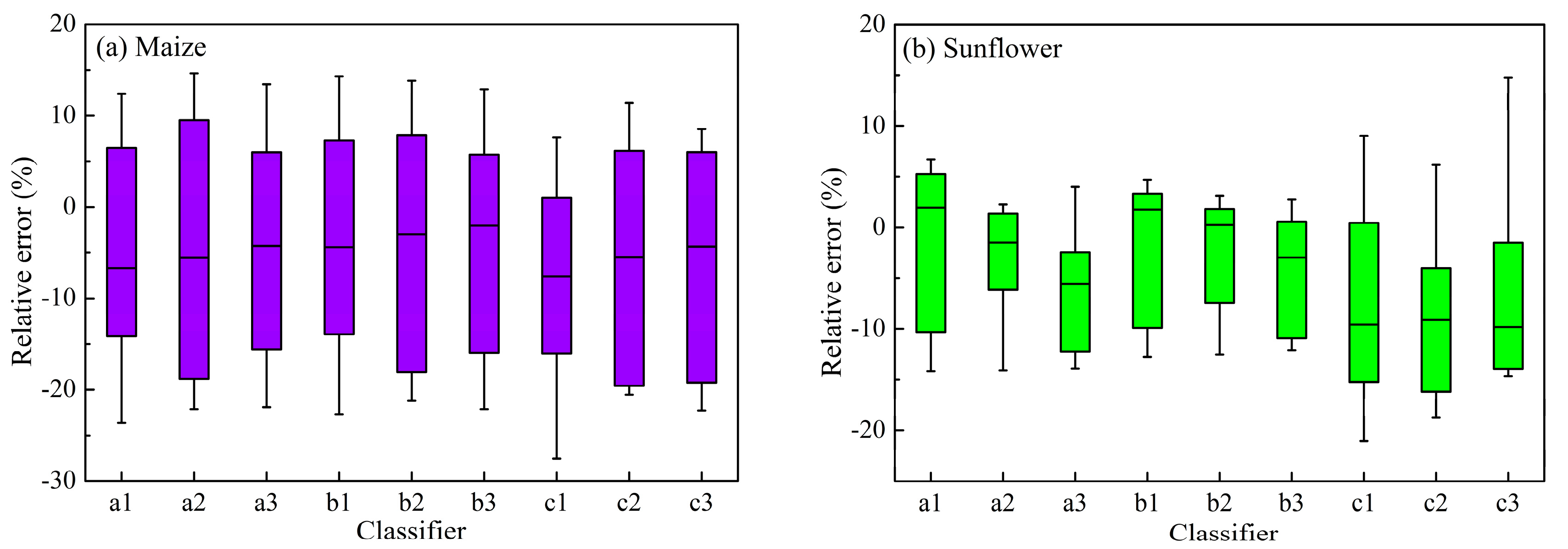
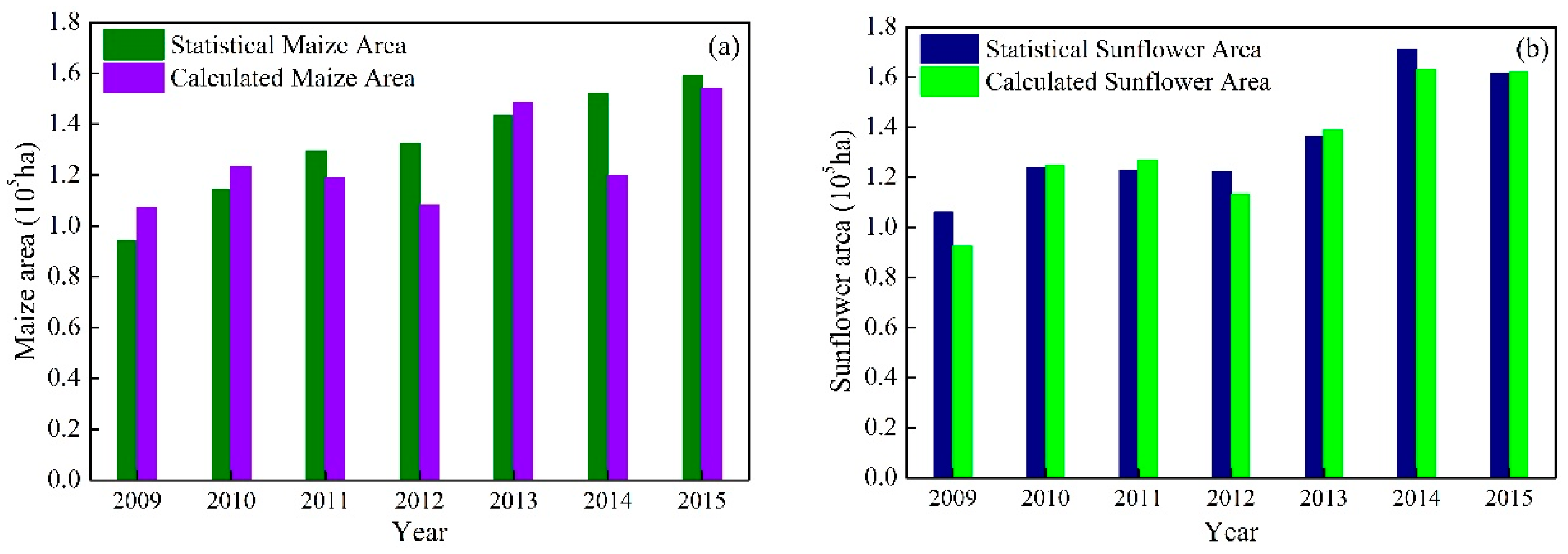

| Maize | Sunflower | ||
|---|---|---|---|
| Growing Period | Date | Growing Period | Date |
| Sowing-Jointing | 5.1–6.19 | Sowing-Seedling | 6.1–7.5 |
| Jointing-Trumpet | 6.20–7.9 | Seedling-Emergence | 7.6–7.24 |
| Trumpet-Heading | 7.10–7.29 | Emergence-Blooming | 7.25–8.6 |
| Heading-Grouting | 7.30–8.19 | Blooming-Grouting | 8.7–8.27 |
| Grouting-Harvest | 9.1–9.20 | Grouting-Harvest | 8.28–9.20 |
| Image Type | Band 1 | Band 2 | Band 3 | Band 4 | |
|---|---|---|---|---|---|
| HJ-1A | CCD1 | 1914.32 | 1825.42 | 1542.66 | 1073.83 |
| CCD2 | 1929.81 | 1831.14 | 1549.82 | 1078.32 | |
| HJ-1B | CCD1 | 1902.19 | 1833.63 | 1566.71 | 1077.09 |
| CCD2 | 1922.90 | 1823.99 | 1553.20 | 1074.54 | |
| No. | NDVI Characteristics | Phenological Metrics |
|---|---|---|
| 1 | NDVI_max, maximum value of NDVI | t_max, time corresponding to NDVI_max |
| 2 | NDVI_inf, NDVI value of the left inflection point with maximum growth rate | t_inf, time corresponding to NDVI_inf |
| 3 | ∆NDVI, difference between NDVI_max and NDVI_inf | FGP = t_max − t_inf, duration from the left inflection point to the peak point (Fast growth phase) |
| Land Use Type | Indexes | 2009 | 2010 | 2011 | 2012 | 2013 | 2014 | 2015 |
|---|---|---|---|---|---|---|---|---|
| Farmland | NDVI_max | 0.497 | 0.505 | 0.497 | 0.519 | 0.552 | 0.592 | 0.573 |
| NDVI_inf | 0.347 | 0.333 | 0.337 | 0.366 | 0.390 | 0.427 | 0.405 | |
| ∆NDVI | 0.150 | 0.172 | 0.159 | 0.153 | 0.162 | 0.164 | 0.167 | |
| FGP | 39.23 | 35.00 | 32.96 | 33.47 | 31.42 | 27.36 | 32.88 | |
| Grassland | NDVI_max | 0.472 | 0.467 | 0.453 | 0.487 | 0.508 | 0.547 | 0.537 |
| NDVI_inf | 0.333 | 0.312 | 0.310 | 0.345 | 0.361 | 0.398 | 0.387 | |
| ∆NDVI | 0.139 | 0.153 | 0.143 | 0.143 | 0.147 | 0.149 | 0.150 | |
| FGP | 38.54 | 34.54 | 33.01 | 32.41 | 31.46 | 27.57 | 32.17 | |
| Forest | NDVI_max | 0.481 | 0.476 | 0.466 | 0.496 | 0.519 | 0.554 | 0.542 |
| NDVI_inf | 0.339 | 0.315 | 0.320 | 0.351 | 0.368 | 0.403 | 0.387 | |
| ∆NDVI | 0.142 | 0.161 | 0.146 | 0.145 | 0.151 | 0.151 | 0.154 | |
| FGP | 38.74 | 34.82 | 32.49 | 32.18 | 31.35 | 27.61 | 32.65 |
| Classifier | Normalization Way | NDVI Index | Maize | Sunflower | ||
|---|---|---|---|---|---|---|
| Fa | Fb | Fa | Fb | |||
| a1 | farmland | NDVI_max | 1.18 | 1.11 | 1.32 | 1.09 |
| b1 | farmland | NDVI_inf | 1.11 | 1.11 | 1.05 | 1.04 |
| c1 | farmland | ∆NDVI | 1.09 | 1.06 | 1.11 | 1.02 |
| a2 | grassland | NDVI_max | 1.18 | 1.12 | 1.22 | 1.00 |
| b2 | grassland | NDVI_inf | 1.14 | 1.02 | 1.04 | 1.02 |
| c2 | grassland | ∆NDVI | 1.19 | 1.04 | 1.06 | 1.00 |
| a3 | forest | NDVI_max | 1.18 | 1.11 | 1.09 | 1.00 |
| b3 | forest | NDVI_inf | 1.18 | 1.11 | 1.00 | 1.00 |
| c3 | forest | ∆NDVI | 1.22 | 1.11 | 1.04 | 1.00 |
| Identified Class | Actual Class | |||||
|---|---|---|---|---|---|---|
| Maize | Sunflower | Others | Total | Correct | Commission | |
| Maize | 23.6 | 3.6 | 3.6 | 30.9 | 76 | 24 |
| Sunflower | 9.1 | 36.4 | 3.6 | 49.1 | 74 | 26 |
| Others | 2.7 | 1.8 | 15.5 | 20.0 | 77 | 23 |
| Total | 35.5 | 41.8 | 22.7 | 100.0 | Kappa = 0.62 | N = 110 |
© 2017 by the authors. Licensee MDPI, Basel, Switzerland. This article is an open access article distributed under the terms and conditions of the Creative Commons Attribution (CC BY) license (http://creativecommons.org/licenses/by/4.0/).
Share and Cite
Yu, B.; Shang, S. Multi-Year Mapping of Maize and Sunflower in Hetao Irrigation District of China with High Spatial and Temporal Resolution Vegetation Index Series. Remote Sens. 2017, 9, 855. https://0-doi-org.brum.beds.ac.uk/10.3390/rs9080855
Yu B, Shang S. Multi-Year Mapping of Maize and Sunflower in Hetao Irrigation District of China with High Spatial and Temporal Resolution Vegetation Index Series. Remote Sensing. 2017; 9(8):855. https://0-doi-org.brum.beds.ac.uk/10.3390/rs9080855
Chicago/Turabian StyleYu, Bing, and Songhao Shang. 2017. "Multi-Year Mapping of Maize and Sunflower in Hetao Irrigation District of China with High Spatial and Temporal Resolution Vegetation Index Series" Remote Sensing 9, no. 8: 855. https://0-doi-org.brum.beds.ac.uk/10.3390/rs9080855





